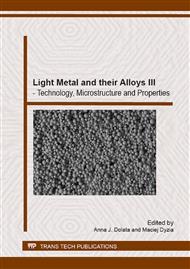p.83
p.89
p.93
p.101
p.109
p.117
p.129
p.141
p.149
The Stress Effects Occurring During Induction Heating of Titanium
Abstract:
In this paper multivariant calculations of induction heating of titanium charge are presented. Calculation model consists of: hard coupled electromagnetic and thermal field analysis and weak coupled stress field analysis. A characteristic feature of titanium is low thermal conductivity. This causes problems with the heating of titanium charges, prolonging the heat treatment time. For this reason, it is preferred to use induction heating techniques, which allow to dissipate the power direct inside the heated charge volume. The side effect of intensified heating can be the appearance of harmful thermal stresses due to the large temperature gradients. Two series of simulations, in order to analyze the influence of the frequency and the supply power on the thermal stress and of the sample, was conducted.
Info:
Periodical:
Pages:
149-154
Citation:
Online since:
November 2013
Authors:
Keywords:
Price:
Сopyright:
© 2014 Trans Tech Publications Ltd. All Rights Reserved
Share:
Citation:


